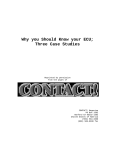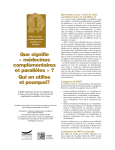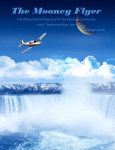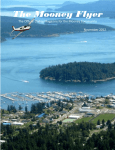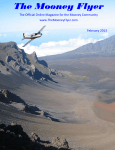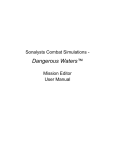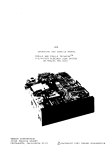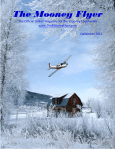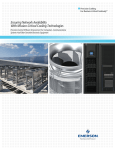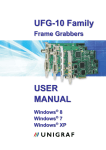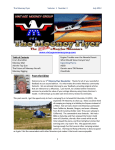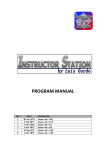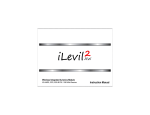Download Present Position - The Mooney Flyer
Transcript
The Mooney Flyer The Official Online Magazine for the Mooney Community www.TheMooneyFlyer.com May 2014 The Mooney Flyer Volume 3 Number 5 May 2014 Contents Features Flying Mooneys in Turbulence Editors Phil Corman Jim Price Phil Corman writes about turbulence and steps you can take to mitigate it in your Mooney Contributing Writers Bob Kromer Tom Rouch Paul Loewen Geoff Lee Linda Corman Michael Riter Cliff Biggs Paul Loewen, of LASAR, talks about broken Carburetor Heat boxes, the corresponding speed loss, and proper repair/replacement To Subscribe Click Here Really, Dude? 1/4 Tank? To Advertise MAPA Homecoming Click Here Paul & Shery Loewen recap the first Homecoming after Mooney International reboots To Submit an Article Click Here Musings on Mooney & Mooneys Carbureted Mooneys M20A-G Pull a Cylinder? We don’t need to pull no stinkin’ Cylinder Cliff Biggs fixes a poor compression cylinder without pulling it or replacing it Getting Your Mind Right MCFI Mike Elliott highlights an attribute of pilots oft overlooked in his quest to help Mooney pilots be the best Taking off with ¼ tank and the other empty? CFI Geoff Lee reflects on Mooney over the Years, Avionics and Repairs Mooney Tales – Glacier National Park Linda Corman writes about the joy of flying your Mooney to Glacier National Park In Every Issue From the Editor Appraise Your Mooney’s Value Website of the Month – Fun Places to Fly Mooney Mail – Feedback from Flyer readers Ask the Top Gun – Tom Rouch answers your questions Upcoming Fly-Ins Internet Clippings – Interesting Stuff we find on the net Have You Heard the News? – Relevant GA news & links for the month Product Review – Foreflight 6 and Stratus 2 fantastic update Click Here to Subscribe 2 Click Here For Back Issues Back to Table of Contents The Mooney Flyer Volume 3 Number 5 May 2014 If you would like to donate to keep The Mooney Flyer healthy, please send your donation via your PayPal account to [email protected] Book of the Month Here are the results of last month’s survey. There was no surprise to us that most Mooney pilots are older than younger. The ages by location are depicted below. 3 Back to Table of Contents Ernest K. Gann’s classic memoir is an up-close and thrilling account of the treacherous early days of commercial aviation. In his inimitable style, Gann brings you right into the cockpit, recounting both the triumphs and terrors of pilots who flew when flying was anything but routine. "This fascinating, well-told autobiography is a complete refutation of the comfortable cliché that "man is master of his fate." As far as pilots are concerned, fate (or death) is a hunter who is constantly in pursuit of them... There is tension and suspense in it but there is great humor too. The Mooney Flyer Volume 3 Number 5 May 2014 Here is this month’s poll. We are curious about the distribution of Mooney models across our active readership. CLICK HERE to cast your vote. Thank You AGAIN to the MSCs These three guys, and their MSCs, held the Mooney community together while Mooney was in hibernation. The “Big 3”, Don Maxwell, Paul Loewen, and Mark Rouch. A deep debt of gratitude to these amazing MSCs! The Mooney Flyer wanted to pay tribute, again, to the Mooney Service Centers that helped owners get through the hibernation of Mooney over the past several years. From left to right are Don Maxwell (Maxwell Aviation), Paul Loewen (LASAR), and Mark Rouch (Top Gun Aviation). They are not only the best, but kept our Mooneys airworthy. A tip of the hat to these guys! 4 Back to Table of Contents The Mooney Flyer Volume 3 Number 5 May 2014 Appraise Your Mooney’s Value Don’t forget about our cool new Appraise your Mooney’s Value using Jimmy Garrision’s valuation. Jimmy is from All American Aircraft, the country’s largest Mooney reseller. We have implemented the models for M20C, M20E, M20G, M20F & M20J. Click on your model to simply complete the valuation. You no longer need paper and pencil. Just another benefit to our subscribers. These forms are currently Beta test quality. Please send errors to us. M20C M20E M20G M20F M20J Fun Places to Fly http://www.funplacestofly.com/default.asp On a rainy day, I use this site to see upcoming events. I can search by state or distance from my home drome. I can also use this to investigate new airports to fly to for lunch or to set up a Mooney fly-in. And if you are really bored, you can peruse all kinds of photos and videos. It’s pretty extensive and up-to-date. As always, it’s up to each of us to keep it current. Enjoy 5 Back to Table of Contents Flying is a hard way to earn an easy living. The Mooney Flyer Volume 3 Number 5 May 2014 I use the articles in The Mooney Flyer to extend my experiences, i.e. like approaching fly-in locations using the simulator to different airports written in the magazine. I also re-live some of the "the engine talked to me" stories, like pulling the power 10nm from a destination in 6000ft. AGL, trying to see if I can stretch the glide in different Wx conditions at the locations of the real event. Joachim H Just wanted to pass along a note on excellent service by an aviation company. Many times we are quick to complain but slow to give kudos when things go right. I had to have a cylinder repaired because of a pulled spark plug Helicoil. Most likely I was expecting to have to replace the cylinder. I called around and found Pacific Continental Engines (10500 Airpark Way, M-10. Los Angeles, CA 91331, 818 899-5200). With a phone call to Chris at PCE, he suggested trying a .010 oversize Helicoil first, rather than replacing the cylinder. I shipped the cylinder to him and he turned it around in 48 hrs. I also found that when the Lycoming factory made the cylinder, (it has about 1000 hrs. on it), they bored the axis of the Helicoil not perpendicular to the spark plug gasket surface. He spot faced both spark plug seats, installed the Helicoil, honed the cylinder for new rings, fitted the rings and sent a complete cylinder gasket kit back. In talking with him, he noted that if I did have to replace the cylinder, he had some known time, low time jugs that he would use, as he doesn't reuse unknown time jugs for repair. Chris did everything he said he was going to do. He did it quickly and I am very pleased with the outcome. At this point I would recommend PCE without hesitation. That's my story an I'm sticking to it! Cliff B Hi Folks, I am a Mooney owner M20A, CFLRV in Canada. I have also purchased 2 other M20A's for spare parts for my old lady, but that is not the reason for this letter. I have been very active in the building of a 1911 Beleriot from plans purchased (could only find german plans). We have been at this for 10 years and hope to fly this year. If you ever wish to do a little write up or article, let me know. You can see our progress and pics at http://www.cahc-ccpa.com/ . We are a museum with no government help and only 230 members. Mike A What a fantastic introduction to the world of Mooney's! Thanks for all your recent help as I worked to acquire an M20J. I needed to 'get smart' quickly on Mooney's and the Mooney Flyer helped me beyond my wildest expectations. Reading past issues I gained knowledge about flight characteristics, maintenance issues, and ownership expenses. When it came time to get an estimated value on the aircraft Phil's assistance was incredible! I spoke with him on the phone and e-mailed the details of the target airplane. In less than 24 hours he provided me two quotes put together by Mooney specialists using the Aircraft Bluebook. We discussed the airplane at length, its strengths and weaknesses, and its fair value. What a great experience! Phil was so generous with his time and expertise. His enthusiasm for Mooney's is refreshing and contagious. I'm now a fan myself. Many thanks again, John S 6 Back to Table of Contents The Mooney Flyer Volume 3 Number 5 May 2014 Flying Mooneys in Turbulence Tis’ the season for turbulent weather as the winter patterns give way to warmer weather. Winds and atmospheric instability make each flight a tad more interesting to pilots and passengers. Mooneys seem to handle turbulence better than your garden variety C or P models. It may be due to the higher wing loading typically found on our Mooneys, but regardless, they seem to ride it out better than most of its competition in class. We probably should start with the definitions of turbulence. Mooney Reaction Occupant Reaction Light Turbulence that momentarily causes slight erratic changes in altitude and/or attitude (pitch, roll, yaw). Report as Light Turbulence or Turbulence that causes slight, rapid and somewhat rhythmic bumpiness without appreciable changes in altitude or attitude. Report as Light Chop. Occupants may feel a slight strain against seat belts or shoulder straps. Unsecured objects may be displaced slightly. Food service may be conducted and little or no difficulty is encountered in walking. Moderate Turbulence that is similar to Light Turbulence but of greater intensity. Changes in altitude and/or attitude occur, but the aircraft remains in positive control at all times. It usually causes variations in indicated airspeed. Report as Moderate Turbulence or Turbulence that is similar to Light Chop, but of greater intensity. It causes rapid bumps or jolts without appreciable changes in aircraft altitude or attitude. Report as Moderate Chop. Occupants feel definite strains against seat belts or shoulder straps. Unsecured objects are dislodged. Food service and walking are difficult. Severe Turbulence that causes large, abrupt changes in altitude and/or attitude. It usually causes large variations in indicated airspeed. Aircraft may be momentarily out of control. Report as Severe Turbulence Occupants are forced violently against seat belts or shoulder straps. Unsecured objects are tossed about. Food Service and walking are impossible. Extreme Turbulence in which the aircraft is violently tossed about and is practically impossible to control. It may cause structural damage. Report as Extreme Turbulence The reality of turbulence is that almost all of the time it is more of a comfort issue than a safety issue. This, of course, is not true if you experience some nasty turbulence or wind shear near the surface. Mooneys are engineered to take a remarkable amount of punishment, and they have to meet stress limits for both positive and negative G-loads. The level of turbulence required to dislodge an engine or 7 Back to Table of Contents The Mooney Flyer Volume 3 Number 5 May 2014 bend a wing spar is something even the most frequent flyer—or pilot for that matter—won’t experience in a lifetime of traveling. Turbulence is caused primarily by wind, frontal activity or convection (updrafts in the summer). There are probably three types of turbulence that can do the most damage to your Mooney and/or you. The first is a Thunderstorm. The convective up/down drafts can exceed 1500-2000 fpm. The bad part is that you may be caught in an updraft and then hit the boundary of the downdraft, or vice versa. This is not good. Penetrating thunderstorms is never advised. Giving them at least a 10 mile wide berth is a good idea. The second type of turbulence to be avoided is mountain rotors, lenticular clouds and mountain waves. Unlike thunderstorms, rotors can be invisible and sometimes Lenticulars look benign. Avoid these also. The third type of turbulence that can do damage is indirect, low level windshear. With windshear, it isn’t the turbulence, it’s the potential loss of control at low altitude that can bite you. How can you avoid turbulence? “Is it better to fly at night than during the day?” Sometimes. “Should I avoid routes that traverse the Rockies or the Alps?” Hard to say. “Are small planes more susceptible than larger ones?” It depends. “They’re calling for gusty winds tomorrow. Will it be rough?” Probably, but who knows. The only way you can positively avoid turbulence, is to never fly your Mooney. Airmets/Sigmets indicate the likelihood of turbulence, but how many flights have you been advised of a Tango Airmet and had a smooth ride, or conversely, had a nasty ride without any Airmet Tangos. Relying on PIREPs, is most useful. You should always consider filing a PIREP when conditions do NOT match those forecast. It’s extremely helpful to your fellow Mooney pilots. The two things you can do that are most effective are to fly in the early morning or late afternoon to take some of the convection out of the equation. Another choice is to fly higher. A third option is to select an alternative route where Airmets and PIREPs are more favorable. It’s usually smoother above clouds and sometimes the “haze layer” indicates smoother air. So What Do You Do in Turbulence? 8 Back to Table of Contents Take PIREPS on turbulence with a grain of salt. One time we were descending into Concord, CA which is nestled between 2 small ridges. A Piper reported Severe turbulence to Oakland Center. We were near the Piper and Center asked about our ride. We reported continuous light with occasional moderate. The Mooney Flyer Volume 3 Number 5 May 2014 If it’s light, you don’t have to do much. Slowing down never hurts and if you think the light turbulence may lead to moderate turbulence, then slowing down is advised. In moderate turbulence, slowing to Va is a smart move. To make your ride a little smoother, you can deploy your speed brakes, or even drop your gear. Disconnecting your autopilot often makes the ride smoother as your autopilot tends to fight the turbulence. Remember that your Mooney has positive stability and will want to return to stable/trimmed flight on its own. Don’t lift every wing drop or pull/push on the yoke with each bump. It exacerbates the uncomfortableness. In severe turbulence, your goal is to keep the shiny side up. Don’t make aileron adjustments or do much pulling or pushing… Just keep the wings level with the rudder and wait it out. Normally, severe turbulence is very brief. Do NOT attempt to maintain altitude! 9 Back to Table of Contents Death is just nature's way of telling you to watch your airspeed. The Mooney Flyer Volume 3 Number 5 May 2014 Pull a Cylinder? We don’t need to pull no Stinkin’ Cylinder Is your cylinder screaming for attention? by Cliff Biggs ATP, 767,757,737,727, A320, LRJet, CE500, MU-2, Wright Bros Award A&P 46 Yrs, B707, B727, B720, B747, DC-10, DC9, DC-8, CE500 It’s time once again for the “Annual” and we look forward with some dread at the compression check, hoping against hope that all the cylinders check out with good compressions. Unfortunately, they don’t always come out good. Your mechanic calls and says, “You’ve got one that’s down at 56 over 80. It’s a leaky exhaust valve”. Now what do you do? You ask him his thoughts and he says to pull the jug and send it out. Well, maybe you should and maybe you should think twice. Maybe it’s time to go back to school . . . . old school! Has your mechanic ever thought of “lapping” the valve in place without removing the cylinder? Many shops and airport repair facilities did cylinder repair routinely in years past, but alas, it’s becoming a lost art. There is no reason why, with the correct tools, a shop can’t try saving a cylinder without removing it. It really depends on how bad the valve is and many can be saved with just a couple of hours of work. Our local shop does several every month on their fleet of Cessna 207s; some of which are down to 20/80. We have a Mooney in, right now, with an O-360-A1D, with #3 cylinder down to 56/80 and a leaky exhaust valve. Let’s go through the procedure with this one and see if we can prevent a pulled cylinder. In the first picture we show the tools required. A valve compression tool to remove the valve springs, a variable speed reversible drill motor, a short length of rubber hose with an ID to match the valve stem diameter, and worm clamps on each end with a short cut off bolt clamped on one end for the drill to grip. Additionally, we need Clover Valve Grinding Compound #A, 280 grit, a piece of safety wire with a small flag of flannel material about ½ inch by 2 inches attached to one end and a cup of gasoline to wash the “flag” in. We’ll also need a good flexible neck, small diameter flashlight and a long very thin screw driver, plus about 10 feet of 1/4 inch rope that we’ll need for the “Indian Rope Trick”. Let’s get started by removing both spark plugs, the valve cover, both rocker arms and push rods. You will need to remove both push rod tubes and pull out both hydraulic lifters to bleed them down. A piece of safety wire pushed into the small end of the hydraulic unit while you compress it with your hand, will bleed all the oil from inside the lifter unit. You need to do this so you can compress the lifter when you reassemble the valve rocker arms on their shafts. Make sure you do not mix them or their parts up. They come as matched sets, don’t intermix them. 10 Back to Table of Contents The rules are a good place to hide if you don't have a better idea and the talent to execute it. If you deviate from a rule, it must be a flawless performance (e.g., if you fly under a bridge, don't hit the bridge.) The Mooney Flyer Volume 3 Number 5 May 2014 Now comes the “Indian Rope Trick”. We need to hold the valve closed while we use the spring compressor to squeeze the springs and remove the spring keepers. To do this, we move the prop backwards so the piston moves down about half way down the cylinder from Top Dead Center and then we push about 8 feet of the rope into the cylinder through the spark plug hole. Once the rope is in, we CAREFULLY move the prop back towards top dead center and compress the rope against the valve in the cylinder head. With a little pressure (and I mean a little) on the prop, you will feel the rope compress. Now we can use the spring compressor to squeeze the springs and remove the keepers and spring assembly. With this completed we can now remove the rope and inspect the valve seating edge by pushing the valve stem back into the head just far enough to see the edge of the valve through the top spark plug hole. With a good light, we can slowly rotate the valve with our fingers on the stem and see how bad the valve edge is. If we see no missing parts or deep eroded areas, we can probably try to save the cylinder. Now comes the need for a little bit of skill and dexterity. With the valve pushed in, we can pick up a small (about 1/8 inch) blob of grinding compound on the screwdriver and carefully insert it through the spark plug hole and deposit it on the edge of the valve. Let’s do this in 3 or 4 areas around the valve edge. Try not to get it on any other areas of the cylinder. Once done, slowly pull the valve back to its seat while rotating it slowly to spread the grinding compound around the valve seat. We may need to do the “rope trick” again to get the rubber hose onto the valve stem. Tighten the hose with the clamp and remove the rope. Now we can lightly pull out on the hose assembly while rotating the valve back and forth and around to get a feel for the grinding compound. Now attach the drill motor to the hose assembly and while pulling out lightly, we can slowly turn the valve both left and right with the drill motor for about 5 seconds each way. Repeat three times and remove the drill motor and hose assembly. 11 Back to Table of Contents The Mooney Flyer Volume 3 Number 5 May 2014 It is imperative now to remove ALL the grinding compound with the “rag on a wire”. Carefully push the valve into the head so you can see the edge again. Take the flag, dipped in gasoline, and insert it into the sparkplug hole, draping the flag between the valve and the valve seat. Pull back lightly on the valve stem and rotate it to start cleaning the compound off of both the valve and seat. Try to get the rag to rotate around the valve seat and then rotate the valve to wash its complete edge. You will need to repeat this process at least 8 times or more to make sure all traces of the grinding compound are removed. By comparing how “rough” the turning of the valve was when we placed the grinding compound on the valve to how smooth it should be when clean, we can tell, if we’ve done a good job cleaning. Visually look at the valve edge also. A small dental camera or a Borescope would be a big help here but not absolutely necessary. Here comes the moment we have been waiting for, a recheck of the compression. 12 Back to Table of Contents The Mooney Flyer Volume 3 Number 5 May 2014 Pull the valve back into its seated position. We don’t need springs on it right now as the air pressure will keep it closed. Put a spark plug in one hole, make sure the piston is at Top Dead Center and hook up the compression tester to the other hole. Carefully increase the air pressure in the cylinder making sure the prop does not rotate and hit you or anyone else. What does the tester read now? Looky here! It’s now reading 72/80. Lots better and useable but let’s try one more time to see if we can improve it a little more. After the second time of lapping we once again try the compression tester and we find we are at 76/80 and this is on a cold check. Looks like it’s time to reassemble, go run it up, get it hot and recheck the compression, like we normally do. One more word of caution on the hydraulic lifters: Don’t mix them up or their parts. They are a matched set. Make sure when you push them back into their respective holes, (they should still be pretty wet with oil), that you hold them in their holes for a few seconds to bleed the air out of the lifter body. Just keep pressure on them and in about 10 seconds you’ll feel the air escape and the lifter will slide deeper into the hole. Now slide the lifter cup onto the lifter hydraulic unit, holding it to bleed the trapped air. Now you’re ready to assemble the rest of the valve train. Of course you’ve thought far enough forward to have new rocker tube seals, tube retention lock plate and rocker cover gaskets available. Now that everything is reassembled and we have run the engine to normal temps, we once again make a “hot” compression check. WHOOPPEE! It’s still at 76/80! Good to go! Quite an improvement and we saved pulling the cylinder. In a couple of hours of shop time we saved many more hours of labor and maybe two weeks of waiting to get the cylinder back from a shop. Worth the trade off isn’t it? Where Dreams Come True 13 Back to Table of Contents Before each flight, make sure that your bladder is empty and your fuel tanks are full. The Mooney Flyer Volume 3 Number 5 May 2014 Getting your mind right by Mike Elliott, MCFI, CFII, FAAsteam Rep. Most of us remember the memorable line from the 1967 classic movie “Cool Hand Luke” when the Warden (Captain) so brilliantly played by Strother Martin asked Luke (Paul Newman) “you got your mind right Luke?” Maybe we need to have the Captain in our heads more often as we prepare for our flights. Most of you know by now that the FAA has had an NPR (Notice of Proposed Rulemaking) advertised for comments that would change the PTS standards for the private, instrument and CFI practical tests. These changes are made in the name of safety, citing the desire to bring the General aviation safety record in line with that of our commercial and military counterparts. While admirable in its stated goals, this is impractical on many fronts. First and foremost is economic. We, as general aviation pilots, cannot afford to train with the vigor and diligence of a commercial or military pilot. They are being paid to train, while we are paying to train. This fact is easily lost in the committee to help reduce GA accidents. Secondly, their standardization of equipment and procedures simply would not work trying to fit a Kitfox pilot and his methods and a Gulfsteam V pilot and his methods all in the same standardized box. But by gosh, continue to try they will. All is not chaotic in our little piece of the sky, however. We have only to look at ourselves and our habits to seriously and positively impact GA’s safety numbers going forward. Let me explain. A couple of weeks ago, I was conducting an IPC with CarolAnn Garratt in actual instrument conditions. The Jacksonville Approach controller was a trainee and he had his hands full of actual condition arrivals, and a couple of other sadists like us out there, doing “just practice” (sorry Alan Iverson). I planned a scenario that would really work CarolAnn out, but it wasn’t nearly as effective as the real life change ups to accommodate everything that was going on. CarolAnn handled it all masterfully, from distractions, to button mashing, to re-routes, to route changes, to holding and circling to land at minimums. Yet, in the debriefing, she was very critical of herself, especially her holding procedures. Mind you, she was well within PTS standards every step of the IPC. We talked about how we as CFI’s can help “better the breed” of Mooney pilots with our training, and she brought up something that has really made me think. Showing me an article in Soaring magazine where an accident occurred because the pilot neglected to make a clearing turn, she asked, “Did the pilot make a mistake by not making a clearing turn that day?” She didn’t wait for my answer, but responded “No, the pilot’s mistake was developing a bad habit of not making clearing turns. This time he got caught and paid the price”. The take away is that we should all expect to fly to perfection each and every time we fly. We should debrief ourselves and keep notes to improve. Don’t settle for Altitude +-100’. Settle for holding the exact altitude and heading. Don’t neglect the checklists, don’t forget to identify the NAVAID. Do make every flight a training flight and if you are uncomfortable in any area, seek out a Mooney savvy instructor to really help you improve. Welcome every little critique from your instructor. That’s why you’re paying him. In short, “Get your mind right”. Accidents are usually the culmination of a chain of events, where if just one of the links in the chain is broken, the accident is avoided. No one sets out to have an accident and would certainly take steps to avoid them, but rusty practices, poor planning and just not having your mind in the game will incubate links in a disaster chain. 14 Back to Table of Contents The Mooney Flyer Volume 3 Number 5 May 2014 Really, Dude? 1/4 Tank?? by Jim Price, ATP, CFI, CFII, MEI, FAAsteam Rep. On April 15th, 2012, a Mooney M20B owner preflighted his aircraft in Rosamond, CA. He reported that his right tank was empty, but his left tank was about “1/4 full”. With his 1/4 tank of fuel, he proceeded to taxi and runup burning from left tank. It was his habit to switch tanks as part of his runup procedure. You guessed it. He took off on the right tank and crash landed after the engine, thirsty for fuel, quit. Fortunately, there were only two minor injuries. It took three months for the NTSB to come up with a probable cause. Their report stated the painfully obvious fact that the pilot experienced, “A loss of engine power during takeoff due to fuel starvation as a result of the pilot’s selection of an empty fuel tank prior to departure.” You’re probably thinking, “Perhaps Rosamond doesn’t have fuel”. According to AirNav.com, they have self serve 100LL. This is a real head scratcher! Let’s Do Some Math How far can a guy fly on 1/4 tank of fuel? The M20B, like the M20C and E can hold 52 gallons. How far can you fly on 1/4 of a 26 gallon tank before that fuel is gone? Not very far. 1/4 tank is about 6.5 gallons. To fly VFR, no matter the model, you need to have 30 minutes of fuel reserve in addition to the fuel needed to fly to the destination. In a M20B, 30 minutes of reserve equals 5.0 gallons. The B model burns about 10 gallons an hour, or about 1.7 gallons per minute. This means that this pilot took off with only 40 minutes of fuel. To me, that’s “Minimum Fuel”, (a fuel situation wherein the pilot feels that upon reaching the destination, he cannot accept any undue delay and needs to get it on the ground – without declaring an emergency!) At the risk of triggering an IRS audit, I wonder why the NTSB’s “probable cause”never mentioned the pilot’s failure to have a proper fuel load. I’m A Big Fuel Sissy 30 minutes of reserve fuel isn’t enough for me. I would never plan a flight, without having the planned burn fuel and at least 60 minutes of reserves. My personal fuel reserve minimums, although just a bit higher than those required by the FAR, have kept my sphincter muscles from getting too much exercise. Keeping Fuel in Your Tanks when Parked Let’s turn to another fuel subject; levels of fuel in your tanks. Mooney owners should never park their aircraft with the tanks close to empty. Doing so, especially in the summer, is hard on the sealant. I’m not alone in this fuel in the tanks reasoning. Weep No More writes in their frequently asked questions area: Is there a way to keep my tanks from leaking? 15 Back to Table of Contents The Mooney Flyer Volume 3 Number 5 May 2014 I have wondered how in the world a 1960’s Mooney could still have original tanks when a much newer airplane has a problem. Some of this may be related to the sealer, but I personally feel tank life is extended by keeping them full and skin temperatures under control. A Mooney parked in the sun on a hot summer day is stressed. This stress is aggravated even more when the tank is not filled. Keep your tanks full and if concerned about the weight of extended range fuel, consider alternating topped tanks between flights. At least this will keep sealer the moist half the time. How About 3/4 to 7/8 Full? If don’t like Mooneys with full tanks, how about keeping the tanks at least 3/4 full? 7/8 full is even better, leaving just enough room for heat expansion. Even if your Mooney lives outside, subject to the sun and heat, the majority of the sealant will be nice and moist. There You Have it! Keeping fuel in the tanks keeps the tank sealant moist and viable and prevents leaks. If you don’t take care of your fuel tanks, who will? Certainly not the Sun. If you neglect your tanks, then there are great shops that specialize in resealing Mooney tanks and they aren’t cheap. In Retrospect A policy of always having 3/4 to 100% full fuel tanks will protect our sweet innocent Mooneys from human error. The FARs concerning reserve fuel were written for a reason and like most FARs, they are written in precious blood. When it comes to the regulations, put an extra buffer between you and the minimum requirements. If you do that, you’ll stand as a great example to others! If you cross that line and take chances – well, you can always serve as a horrible warning to others. Fly Safe Jim 16 Back to Table of Contents The Mooney Flyer Volume 3 Number 5 May 2014 Mooney M20 A, B, C, D, & G Carbureted Mooneys By Paul Loewen—Lake Aero Styling And Repair Common with the early Mooneys built before 1964 and later M20C & G models is that they all have the Lycoming 0-360-A1A or 0-360-A1D, 180 HP engines. These carbureted engines have engine intake plumbing and a “Carburetor Heat Box” to control carburetor icing. Our POH says “Warning: Apply full carburetor heat when reducing power for descent or landing.” I did not find any maintenance data on the induction system other than how to clean the air filter in all the Mooney manuals. There are 3 versions of the airbox that have evolved in design over the years. I had some that needed repair due to wear, and some were cracked and needed weld repairs. I soon felt the condition of most heat boxes needed some re-design help and better maintenance. I remember once getting a phone call from a M20C owner who said he had lost 5 mph in cruise speed and wanted my help to discover why. He later called me and told me that he found the cause. He removed the 1” SCAT Duct from the heat box bypass where he could see that the bypass valve was not working correctly, allowing hot air to enter the carburetor all the time. When he corrected the valve operation, he got his 5 mph back. By-pass valve with steel tube and bronze bushings When looking at the deteriorated condition of heat boxes, I found all were worn, allowing too much heated air all the time, even though the mechanical function was operating correctly. I set out to see if I could improve the obvious wear issues. The original designs were wearing “steel against steel” or steel against aluminum which is not adequate for long time operation. 17 Back to Table of Contents The Mooney Flyer Volume 3 Number 5 May 2014 New Factory parts would provide a fix until they would, too soon, wear out again. We made some new bushings of aluminum nickel bronze for the new steel shaft, some new doors, with more felt, to better seal out the hot air. We made a new by-pass valve assembly with some new aluminum and steel tubing that could accept some New replacement Parts and “ Aluminum Nickel Bronze” hat bushings industrial bronze bushings for the steel shaft there. I cut off the old worn by-pass tube, so the new one could slip on as a replacement. I made two design seals around the main door shaft and inside the airbox to lessen the flow of hot air to the carburetor. When I felt that I had improved 4 of the heat boxes, I needed to test the results. I set up two hair dryers and a vacuum cleaner for air flow sources. A digital temperature gauge was set in the portion that would connect to a carburetor. This was not a sophisticated test set up, but it did provide results that could be measured. Our best sealed airbox allowed no hot air to pass with the hot air source on a low setting. However, on a high setting, it did allow hot air past the valves and doors; much improved over a worn unit. With an ambient air temp of 78 degrees F, we could see 150 degrees F when carb heat was selected “on”, and a 39 degree heat rise (115 degrees F) from leakage when selected off, when using the high setting on the hair dryer. Now thinking about my test, the low setting on the hair dryer would best represent the actual condition on the airplane, as the by-pass would be open, and passing hot air pressure during normal operation. However, the high setting did prove it could still leak hot air to the carburetor if the by-pass valve was mis-rigged or closed. As we learned from inner coolers installed on Turbocharged Mooneys, the engine performance was greatly affected by the inlet air temperature. I believe the placard says, “reduce manifold pressure 1” for each 10 degrees of temperature cooling.” 18 Back to Table of Contents The Mooney Flyer Volume 3 Number 5 May 2014 In conclusion, the condition and operation of the aging carburetor heat boxes has been long overlooked as to the ultimate performance of the carbureted Mooneys. I think most mechanics, when inspecting the airbox, may feel it is functioning correctly if the door moves and the valve moves when operated, and there are no big chunks missing. Don Maxwell of Maxwell Aviation has a good article on the airbox on his website, http://www.donmaxwell.com/publications/MAPA_TEXT/Carb%20Heat%20Maintenance/CARB_HEAT_C ARE.HTM How would you like to find more power and a missing 5 mph cruise? 19 Back to Table of Contents The Mooney Flyer Volume 3 Number 5 May 2014 Worn shafts needing replacement Repair box with new shaft and hat bushings Doors with bad seals worn away Leakage of hot air due to worn shaft and bushings Leakage of hot air due to worn shaft and bushings 20 Back to Table of Contents Three carburetor Heat Box designs used on different years and Mooney models are shown below The Mooney Flyer Volume 3 Number 5 May 2014 Below: These air boxes by-pass the hot air on the firewall with the cabin heater control box valve. Hot air is controlled by the door – closing off the hot air for climb and cruise and providing only hot air for decent. 21 Back to Table of Contents The Mooney Flyer Volume 3 Number 5 May 2014 MAPA Homecoming, 2014 By Paul and Shery Loewen Paul and I have been going to the MAPA Conventions for 34 years now, and this Homecoming had a new “flavor.” This year we met at Schreiner’s Field in Kerrville, Texas in a large hangar behind MAPA’s new offices, and across the runway from the Mooney Factory. There was a large crowd (over 200) with a surprising number of first-timers. The new CEO of Mooney, Dr. Jerry Chen, along with many of the Factory staff were very available to meet and greet the attendees. Homecoming was “kicked off” on Thursday evening with a reception and showing of a DVD video, “Boots On The Ground”, produced by Mitch Latting and Jolie Lucas, founders of Mooney Ambassadors. It was filmed at the Mooney Factory and featured the men and women of Mooney….the people who made Mooney. Factory employees and their families, as well as MAPA attendees…..close to 400 people in all….. enjoyed the viewing, and the popcorn, lemonade, soft drinks and cake that went along with it! Friday morning began with MAPA President, Trey Hughes, welcoming everyone, giving insight as to what to expect at this year’s Convention, and introducing Dr. Jerry Chen, the new CEO of Mooney International Corp. Dr. Chen shared his visions for the future of Mooney and some of the upgrades to expect in future Mooney Airplanes. There are now 85 employees, and he emphasized the company motto as Safety, Speed, and Style! The first Mooney to be produced (July 2014 target date) will be auctioned off, with all proceeds going to a new Mooney Museum. Sessions and events that followed on Friday included: “New Taxes and Your Mooney” with Tom Harnett; “Pinch Hitter Ground School” with Jan Maxwell and Jolie Lucas; “Pilots ‘N Paws” with Dave Morris; “Aircraft Values” with Jimmy Garrison; a “Ladies Luncheon and Style Show”; “Mooney Maintenance” with Don Maxwell with a little help from Paul Loewen of LASAR and Mark Rouch of Top Gun; “Into Thin Air” with Dr. Bob Achtel; “Painting your Mooney” with Teresa Venegas; “Flying on your Drivers License” with Dr. Larry Marshall; and “Electronic Flight Bag” with Craig Steffen. 22 Back to Table of Contents The Mooney Flyer Volume 3 Number 5 May 2014 The evening ended with the traditional Ice Cream Social, but this year something new was added….. an auction. Many wonderful items were auctioned off, but the one that got the most laughs was a pair of Don Maxwell’s Speedos. They brought in $375 from the highest bidder, Trey Dibrell, who donated them to the future Mooney Aircraft Museum. Saturday began with a “Flight Review” by the MAPA Safety Foundation, a seminar on “Formation Flying” with the Mooney Caravan organizers, and one on “Continental Engine Care” with Nicholas Dopfel. Mooney Factory Tours followed, and Paul and I were Paul Loewen dispensing Mooney Knowledge very impressed with all the changes. The Factory has been re-organized to streamline the manufacturing process. New LED lighting has been installed, more efficient methods have been put into place, and equipment manufactured in the 1930’s has been replaced with new technology…...and more!! Lunch was on the runway, and the “Beauty Contest” and voting for our favorite Mooneys took place in the afternoon. The weather was incredibly nice during the entire event, and it was fun walking the runway, admiring all the beautiful Mooney Airplanes. At the Awards Banquet, Tom Bowen, who has returned to Mooney as the COO/Engineer, honored the 11 employees who held Mooney together during the “dark days.” Door Prizes were given out, and Beauty Contest winners were announced. The keynote speaker was Jack Wiegand, a delightful 21 year old who holds the World Record for a Solo Flight around the world. He began his journey in Fresno, California, and flew 138 hours with 20 hours on instruments in a Mooney Ovation, N432BG. The most expensive fuel was in Mumbai, India at $35 a gallon, because it had to be brought in in containers. He had 20 sponsors, and proceeds from his flight went to the Big Brothers and Sisters Program. All in all, the Convention was a huge success, and Paul and I were so pleased to be in attendance. Great job MAPA staff! AND we are VERY excited about the future of Mooney International Corp! 23 Back to Table of Contents The Mooney Flyer Volume 3 Number 5 May 2014 Musings on Mooney & Mooneys by Geoff Lee, CFI It was pleasing to read the announcement in “Flying” magazine that the Mooney aircraft is back in production, but Wow! $700,000 to $800,000 per aircraft. One has to wonder what income bracket the average Mooney owner will fit into in about 20 years. The plane looks almost the same as it did in 1968 when I bought a factory new Mooney Executive for $18,600. The available instrumentation and communication facilities have certainly become more sophisticated. They now require almost as much attention to learning how they function and how to fully utilize their capabilities as that required to grasp the basic skill of flying. I know it is supposed to be easier, but many current pilots did not grow up using an iPad or an iPhone. I would suspect that currently there is a paucity of flight instructors that can adequately instruct in aircraft that have the very latest touch screen and flat panel technology. For certain, that will change over time as the aging fleet replenishes itself with aircraft having these new electronic wonders. Indeed, the up-coming young instructors regard touch screen, screen controllers and flat panel as normal/ basic equipment. The advance of avionics and autopilot development has far outstripped the progress of aerodynamic designs and continues each year to get better and better at flying the aircraft for the pilot. This includes automatic takeover of the missed approach function and incorporating portions of the “see and avoid” function that is a necessary duty of the pilot. I recently had some interesting aerial gyrations in a flat screen equipped aircraft when I intentionally disabled the screens while the pilot was under the hood. All the integrated/ interdependent functions in the new glass panels are incredibly interesting to look at and certainly draw one’s attention. The multiple screen capabilities can present an overabundance of information that would be better suited to a cockpit having two pilots, particularly under IFR conditions. Flat panel screens are reliable but concern must remain that the pilot loses a great deal of information if they go black, or the touch screen controller battery dies – particularly if the plane is in a cloud or it’s dark. Electronic situational awareness is not a good thing if the single pilot has allowed basic flying skills and situational awareness to erode and has become completely reliant upon electronic equipment. 24 Back to Table of Contents The Mooney Flyer Volume 3 Number 5 May 2014 A page of comparisons in the April “Flying’ publication reveals that the new /old Mooney airframe is still the fastest aerodynamic design available in the single engine piston realm. I am feeling good about my old 1979 231 Rocket which will out run the forthcoming new Mooney Acclaim and has a 200lb greater useful load. The venerable Bonanza on that page appears arthritic when one views its speed and useful load comparisons. The rivet free plastic airplanes are certainly slick and are probably the future, but I am still a tenacious fan of aluminum skinned aircraft. I just finished my annual inspection on the 231 Rocket. All was well except that my ELT battery had expired and the Dukes electric boost pump was exuding a small amount of fuel via the drain fitting just aft of the pilot side cowl flap. One would never see this significant event from the cockpit during a normal start and it could have been present for some time. It is significant in that it will not drip fuel unless a seal internal to the pump has deteriorated and is allowing fuel to leak passed its location. The seal blocks fuel from reaching the electrical section of the motor which would not be a fun event. To test your boost pump, with the engine off, simply turn on the master and then activate the low boost switch while someone outside the aircraft observes the drain fitting. If fuel drips out, you need to have it rebuilt or replaced. Rebuilt pump The fuel has to get passed the bearings first before engaging the seal , so dripping fuel also signifies that the motor bearings are worn. I 25 Back to Table of Contents The Mooney Flyer Volume 3 Number 5 May 2014 removed the pump and sent it to C. J. Aviation in Florida for rebuild. They promptly rebuilt the unit in 2 days and returned it via UPS; the cost was $850 plus shipping. That figure is not inexpensive for rebuilding this simple device, but relative to the prices quoted from other vendors it is the most reasonable and the service was fast. The new pump requires careful examination prior to installation. The pump has an “out” port and an “in” port. These ports are so marked on the casting area. Using the pretty new label from the rebuilder as an orientation guide can get you into trouble. All the pertinent labeling on my pump was applied to the opposite side with reference to the original pump so “in/out” elbows and drain outlet would be reversed if placed with reference to the old pump labeling> The mechanic got caught on that one! All the nice new labels end up un-readably facing the underside of the cockpit floor when the unit is oriented correctly in the Mooney. Mooney Aircraft Co. in Kerrville quoted $1700 for a new replacement Weldon pump. The C.J. Aviation rebuild cost was over $400 cheaper than the price quoted for a rebuilt exchange pump from Aircraft Spruce ($1295), or Quality aircraft. The Dukes boost pump is no longer used by Mooney. The aircraft checklist calls for this electrical boost pump to be on for departure as a backup to the engine driven pump. However, one failed some years ago in my 1968 M20F while on climb out, putting metal particulates in the fuel system. I still elect to use the pump only for engine start procedure and simply remain poised to switch the pump on should fuel pressure diminish or the engine go quiet in flight. Old habits die hard. The pump is not to be used for continuous operation. I do not advocate that anyone deviate from the recommended operating procedures in their own aircraft. My current Dukes pump has lasted since I bought the 231 new in 1979, but maybe because it has been minimally used. 26 Back to Table of Contents The Mooney Flyer Volume 3 Number 5 May 2014 Glacier Park, Montana by Linda Corman A couple of years ago we made it to Glacier National Park in Montana. We had been dreaming about a flight to Glacier Park for many years and couldn’t seem to find the time. Finally, after attending a Mooney fly-in to the Methow Valley in Washington, we decided to go since we were already halfway there. So why not go. The flight to Kalispell was pretty interesting. There were huge wildfires all over the western part of the U.S., so we didn’t see much on the ground. We were flying over some beautiful country and we felt a little cheated. The tops were well over 18,000’, so we were stuck in the smoke. After our arrival in Glacier Park International Airport, we rented a car and headed to our hotel. We found an inexpensive hotel in Kalispell, not knowing at the time it was the furthest from the entrance to the Park. After breakfast the next morning we headed out to the Park. The drive to the west entrance was about 35 miles through some lovely canyons and beautiful mountain areas. On the outskirts of the park we located a small grocery store to stock up on water and were surprised to find some of the wines we usually find in California, especially Paso Robles. We drove up “Going to the Sun” road. After we entered the park we immediately started looking for any wildlife, especially bears. To our disappointment, we did not see any bears that day. We did stop at the lookout point to Hidden Lake in 27 Back to Table of Contents The Mooney Flyer Volume 3 Number 5 May 2014 the middle of the park and hiked to the top. There, we saw mountain goats that seemed very tame. They didn’t move as we approached. As we were going to do our major hike the next day from the East entrance, we decided to head back to town for dinner. We drove back and diverted to Whitefish and Whitefish Lake. We walked around the town of Whitefish looking for a restaurant for dinner. The town was very lovely with more than adequate stores, interesting local arts, a Railroad museum and crafts. After 5pm, the restaurants finally opened and we thought Italian food sounded good. We found a cute place called Ciao Mambo at 234 East 2nd Street in Whitefish. It was worth the wait as the food was great and the wine was even better, as it was a California wine from Paso. It turns out the man responsible for the Whitefish airport and many of the local businesses, including our restaurant, is Bill Foley the owner of several wineries in California. The next morning we set off early as the hike we planned was going to take us most of the day. We drove to the East entrance of Glacier Park. This day we were not disappointed with the lack of bears as they were everywhere. As we drove along we spotted a couple of Grizzlies playing in the lake and sunning on the beach. I guess they too take vacations at the lakeside. We found the hike we wanted; Grinnel Lake and Glacier which was an easy 7 mile roundtrip. On our way to Grinnel Lake we spotted a Moose and on the way back encountered a mother Grizzly bear and a couple of cubs coming up the hill from the lake edge. We stopped and let her pass without either her of the cubs even making eye contact. After our exciting day in the wilds of the Park we decided to stop at the Many Glacier Lodge for drinks and lunch. The Lodge has been around a long while and is very quaint with a long covered porch facing the lake. We rested and refreshed ourselves, then headed back to the park entrance. On the way we saw a bunch of cars parked along the roadway with people hopping out to take pictures. They were along the roadway and we just assumed they were site seeing. Of course we also pulled to the side to see what everyone was looking at. Surprise! A mother and her three cubs was the attraction and we parked next to them! They paid us very little attention and kept on eating their berries. They finally wandered away after we got a nice movie of them. Driving along, we saw the same bears we had seen earlier in the morning, still at the lake edge. But, this time, a ranger was shooing them away with bean bag rounds from her shotgun. She told us the bears were getting too familiar with people and cars and needed to be moved along. The next day, we decided to explore the surrounding area and drove to Bigfork and Flathead Lake. On the way we passed a distillery called Whispering Andy’s. I had never tried “distillery tasting”, so we stopped to give it a try. The liquor was interesting, but I really liked the rum they made and I had to bring some home. We drove back up to Whitefish because we had heard there was a beautiful ski lodge in the foothills just outside of the town. We found the resort and got excited about doing a zip line through the trees until we found out the wait was going to be at least three hours. We then drove back into town and ate at a lodge next to Whitefish Lake. The food was wonderful and the view was even better from the patio eating area. 28 Back to Table of Contents The Mooney Flyer Volume 3 Number 5 May 2014 The next day was our day to head for home. We got another early start since we weren’t sure if the fires were still making smoky skies and we had a long trip back to Paso Robles. The skies were clear. I highly recommend a trip to Glacier National Park as there is so much to see and do for nature lovers. We will probably be back for a return trip as we couldn’t see everything in so short a time. But of course, without our Mooney, we would never have gone. Getting There Where to Stay What to Do We flew into KGPI and used Glacier Jet Center. The field is towered and Glacier Jet Center took good care of us and our Mooney. There is an alternate field in Kalispell, S27, but it is further from the park. We recommend staying in the Park at either Many Glacier Hotel or Glacier Park Lodge, at the east entrance. Many Glacier Hotel is in the middle of the park on a lake and near all the good hiking and boating. There are 3 hikes we recommend. First, at the top of “Going to The Sun” road, take the easy hike to Hidden Lake. You feel like you are on top of the world with astounding vistas. The field has wide open approaches from both ends of the runway. Rental cars are readily available. From the east entrance, try Grinnell Lake and Grinnell Glacier. Grinnell Lake is an easy flat hike to an amazing valley and lake. Other Things to Do Definitely take a side trip to Whitefish and to the Whitefish Mountain Lodge. The Lodge has skiing in the winter and ziplines, an aerial adventure park and mountain slides. The town of Whitefish is worth an afternoon. Also from the east entrance is Iceberg Lake. Don’t forget to include Big Fork and Flathead Lake. There is even a distillery there where you can taste some unique alcohol. Things to Do in Your Mooney Don’t forget to take a flight over Glacier Park. It is a unique and amazing perspective of the park. 29 Back to Table of Contents The Mooney Flyer Volume 3 Number 5 May 2014 Mooney Tool Bag by Phil Corman You are travelling in your Mooney and everything is going fine. Then you find something amiss with her. What if there is not a mechanic on the field? Or what if there is a mechanic on the field, but he doesn’t have the “one part” you need. Read on… this might save you some time and/or money. The first thing to consider is the toolbox. I’m always very weight conscious, so we recommend a durable plastic tool box. You won’t be handling the box that often, hopefully, so lighter weight is a good tradeoff. Now let’s get to the essentials in your tool box: 1) Screwdriver(s) – for compactness and utility, why not consider one with interchangeable bits. I have one that has the bits in the handle, a nice space saver. Don’t forget to get a stubby screwdriver for those tight spaces. 2) Pliers – There are no “One-Plier-Fits-All”, especially for Mooneys. Consider a pair of regular pliers to start, slip joint pliers, needle nose, and a straight jaw vise grip. 3) Wrenches – Start off with combination wrenches. I like the ones that are open on one end and closed on the other, running from at least ¼” to ¾”. On the adjustable side, these are like the MacGyvers of wrenches and provide for the time that you need 2 of the same size. They also double as metric wrenches in case you stumble on a nut or bolt that’s not SAE. And last but not least, include socket wrench set. Include both ¼” and ¾” drives. And don’t forget a universal joint and a couple of extensions. And make sure you have one socket for your spark plugs and another for your spin on oil filter. 4) For electrical issues, a small multimeter is essential. If you suspect a bad avionics connector, bring a 3/32” hex wrench. Many avionics are anchored with this… and include “contact cleaner” in your bag to clean the connectors. 5) Other things in your bag should include a Flashlight, a magnetic pickup tool (when you drop a screw, you will thank us greatly), an inspection mirror on a stick, a tire gauge, an air pump and a spark plug gap gauge. Some people carry a Jack, but that’s too heavy and bulky for my Mooney. When all else fails, include a hammer. You never know when some carefully driven hammer can loosen something stuck. And while we are on that topic, don’t forget to include a roll of duct tape, for things that are moving that shouldn’t, and a spray lubricant. 6) Manuals – If you don’t have your Service Manual, POH, and Illustrated Parts Manual on your iPhone and/or iPad, do so today. After Foreflight, the second best tool for your Mooney is iBooks with these manuals. 30 Back to Table of Contents The Mooney Flyer Volume 3 Number 5 May 2014 Now let’s cover some essential parts to carry: 1) If your alternator is driven by a belt, bring a spare 2) Bring 1-2 spare spark plugs… these do NOT have to be new… just serviceable 3) If you want to do so, carry a spare tire tube. 4) Safety wire and tie wraps 5) Paper towels 6) Seems obvious, but it’s smart to carry a couple quarts of oil 7) Lastly, bring a dozen each of the main metal screws used on your wings and fuselage, a few nut plates, and a few camlocs that are used on your cowling. When did your passion for flying begin? 31 Back to Table of Contents The Mooney Flyer Volume 3 Number 5 May 2014 8) May 10, Winter Haven (GIF) June 14, Punta Gorda (PGD) July 12, Williston (X60) August 9, St. Augustine (SGJ) September 13, Lakeland (LAL) October 14, Flagler (XFL) November 8, Vero Beach, (VRB) December 13, Punta Gorda (PGD) May 3: Conroe, TX. CLICK HERE for details August 22-24: Gold Beach, Oregon – Join us for a fun-filled weekend to the coast of Oregon. We’re arranging for discounts at The Inn of the Beachcomber and a Jet Boat tour up the Rogue River. CLICK HERE to check out the area. More details later. June 18-22: Join us for a 5-day fly-in. We will be heading for the Baltic Sea area: the islands of Ruegen (Germany) and Gotland (Sweden). CLICK HERE for the official information. May 10: Quakertown,PA (KUKT) for a picnic fly-in at noon. Basically, it will be one of the normal picnics we hold up at Bobby's hanger every spring. As always everyone is invited to attend, we will be cooking up hot dogs, hamburgers and anything else that people decide to bring The 2nd Mooney Summit will be hosted by Mike Elliott and Dr. Ron Dubin October 24-26, at Panama City Beach, FL. 32 Back to Table of Contents The Mooney Flyer Volume 3 Number 5 May 2014 Internet Clippings Why Do Piston Engines Fail? Here’s another great article by Mike Busch, the Savvy Aviator on why piston engines fail! CLICK HERE to read the article. We were interested to learn that crankshafts often last through 7 TBOs… AOPA: What to Do if stopped by Law Enforcement Every situation is different and every person’s personality in responding to law enforcement is different, so giving and taking advice about how to handle a situation will vary. Still, a few general principles can apply to most situations and help any pilot be informed and prepared if approached by law enforcement on the ramp of an airport during a flight that is wholly conducted within the United States. Step 1: Ask the law-enforcement official in charge about the nature of his or her inspection of your certificates and your aircraft, including what he or she is intending to do, why, and under what authority. Step 2: Request to see the credentials of the lead official and any other officials who are present and try to record the names, phone numbers, badge numbers, and agencies of those officials. Step 3: Law enforcement will most likely will ask you for your pilot and aircraft documents. Note: FAA Regulations 61.3(l) and 61.51(i)(1) state that a person must present his or her certificates, authorizations, identification, and other documents required under Part 61 for inspection upon a request by the administrator, NTSB, or any federal, state, or local law enforcement officer. FAA Regulation 91.203 requires that effective airworthiness and registration certificates be carried on board the aircraft and be displayed at the cabin or cockpit entrance so that it is legible to passengers or crew, but this regulation does not create a right to board or enter the aircraft. And, 49 USC § 44103(d) requires that the operator make the registration certificate available for inspection when requested by a United States government, state, or local law-enforcement officer. Pilot logbooks may not be required to be carried on board the aircraft and, therefore, you may not be required to present them for inspection during the stop by law-enforcement officers. Exercising privileges of recreational, private, commercial, or airline transport pilot certificates: — Must have pilot certificate. — Must have appropriate photo ID. — Must have medical certificate. — Does not have to have logbook in possession, but may be required to present logbook for inspection after receiving written request. Exercising privileges of sport pilot certificate: — Must have pilot certificate. — Must have appropriate photo ID. — Must have valid U.S. driver’s license or medical certificate. — Must have evidence of required authorized instructor endorsements. Exercising privileges of student pilot certificate: — Must have student pilot/medical certificate with appropriate endorsements. — Must have appropriate photo ID. — Must have logbook with appropriate endorsements. Exercising privileges of glider or balloon rating: — Must have pilot certificate. — Must have appropriate photo ID. Note: Law enforcement may ask for other documents than those specified under FARs. For example, existing guidance by CBP to law enforcement incorrectly suggests that pilots must present for inspection a flight’s weight and balance calculations, aircraft logbooks, etc. AOPA is working to correct this misinformation. Step 4: The law enforcement officials may ask to search your aircraft or state that they are going to inspect or search the aircraft and its contents visually, physically, or with dogs. Consider responding with the following statements: — “I do not consent to this search, but I will not interfere.” — “If you remove or disassemble any part of this aircraft, including inspection plates, you may be rendering this aircraft unairworthy.” Step 5: If you are a member of AOPA Pilot Protection Services, and it is between 8:30 a.m. and 5 p.m. Eastern time during a business day, call 800-872-2672 or 301-695-2257 to speak with a Legal Services Plan counselor. Step 6: If possible, record the event with a camera. However, law-enforcement personnel may react negatively to being photographed or recorded in the conduct of their business and may object or advise that doing so is not allowed. Note the location of any security cameras on the airport ramp. Make detailed written notes during the event or as soon after as ractical. Identify any other persons present who may be witnesses to the inspection and search. Step 7: Check your emotional status! Are you able to continue your flight safely after such an ordeal? 33 Back to Table of Contents The Mooney Flyer Volume 3 Number 5 May 2014 Send your questions for Tom to [email protected] Question 1: Should I change my donuts (landing gear discs) after so many years or after some measurement is out of tolerance? Years of service mean nothing, but tolerances do. With the shock discs there are gap measurements that are important, since as you touch down, (I know everyone greases their Mooney to a smooth landing), but that gap can really send a shock through the landing gear and to the wing.. We also look closely when we jack the airplane to see if the discs expand immediately. All you need to do is reach down and see if you can move the gear(especially the mains) as soon as it is jacked. If you can move the gear back and forth, then you know the rubber has hardened and virtually worthless. I have seen gear that have been so compressed that the bottom of the gear doors are damaged and the top cove4rs on the stack gone. These covers are on models from about 1988 and on. Question 2: What advantages are there to an MSC over a solid mechanic? Enjoyed this one and I hope you have both. There are many very good independent mechanics out there. I get calls frequently from mechs working on a Mooney and have questions about something peculiar to a Mooney, and that is your "solid mechanic". The main advantage is exactly that, an MSC should have a lot of Mooney experience that your solid mechanic doesn't have and also up to date info from the factory plus immediate access to the Mooney engineers. I can tell you this, because of our experience, there are a lot of jobs on a Mooney that we can do in far less time than a non-MSC mech. 34 Back to Table of Contents The Mooney Flyer Volume 3 Number 5 May 2014 May 2014 ADS-B Ground Radio Network is Completed, FAA Says The U.S. Federal Aviation Administration announced the completion of the ground-radio infrastructure for automatic dependent surveillance-broadcast (ADS-B), the surveillance piece of its NextGen ATC modernization effort. Of 230 ATC facilities nationwide, 100 already track aircraft by ADS-B, the agency said. Ground stations receive the ADS-B position broadcasts and pipe the data to ATCfacilities, where it is fused with primary and secondary surveillance radar tracks and presented on controller screens. The data is also used to generate traffic information services-broadcast (TIS-B) reports that are uplinked to ADS-B equipped aircraft. ADS-B updates aircraft position once per second, whereas radar updates every 4.7 seconds or longer. The FAA said it expects the system will be “connected and operating” at all 230ATC facilities by 2019. Read More 35 Back to Table of Contents The Mooney Flyer Volume 3 Number 5 May 2014 Accessories introduced for GoPro and iPhone April 18, 2014 by General Aviation News Staff Sporty’s and NFlight Technologies have introduced the first variable propeller filters for pilots flying with the GoPro or iPhone. These filters can be combined with headset audio cables to make complete cockpit video kits, according to Sporty’s officials. Almost all video cameras suffer from the “rolling shutter effect,” which distorts the propeller and can ruin a good video. With the new Variable ND Filter, pilots can adjust the darkness of the filter to suit different lighting conditions and different airplanes. The result is a clear and professional video every time, Sporty’s officials said. For GoPro users, the filter snaps onto the GoPro waterproof case or skeleton case, and is removable for use outside the cockpit. For smartphone users, pilots attach the metal bracket to the outside of their phones and line up the filter over the camera lens. The adjustable case is compatible with most smart phones, with or without case, including the iPhone and Samsung Galaxy. Sporty’s offers a complete kit for the GoPro that includes a variable ND lens filter, headset audio cable, skeleton case and suction cup mount. With this, pilots can record HD video, plus ATC and intercom audio. The filter and the kit are compatible with the GoPro Hero3+. For a complete iPhone video solution, Sporty’s offers the Deluxe iPhone Video Kit, which includes the Variable ND Filter, custom audio cable and suction cup mount. READ MORE 36 Back to Table of Contents The Mooney Flyer Volume 3 Number 5 May 2014 Product Review: ForeFlight 6 and Stratus 2 Split Screen Attitude Stratus 2’s new firmware update, combined with ForeFlight 6, unlocks Stratus 2’s Attitude Heading Reference System (AHRS). This data can now be displayed on ForeFlight, with a glass cockpit-style splitscreen view. The Garmin Pilot and WingX Pro iPad app (and, in the case of WingX, an iPad and Tablet app), these tools already incorporated the AHRS feature. ForeFlight and Stratus are continually trying to improve their product and give pilots more and more features. The attitude indicator updates multiple times per second so it moves smoothly, and it can be used in either portrait or landscape mode. It’s easily accessed. Just tap on the Attitude Indicator symbol on the map page. Below are the landscape and portrait views of the AHRS split screen with Stratus 2 connected. With the split screen, pilots can now view ADS-B weather, traffic, moving map and attitude all at the same time. 37 Back to Table of Contents The Mooney Flyer Volume 3 Number 5 May 2014 For those who like to mount the Stratus 2 on the side window with a Ram Mount, you won’t be pleased with the next photo. Because the AHRS is sideways, it believes it’s in a 90o right bank. Yet, Sporty’s recommends this side window mounting method for those who are in a poor area for ADS-B tower reception. For the best reception, Sporty’s recommends the Stratus external antenna. Stratus Replay Stratus Replay nearly doubles the effective battery life of an iPad by allowing pilots to turn off the screen between uses. When the screen is turned on again, Stratus automatically sends ForeFlight Mobile any ADS-B weather that was missed, including radar, METARs, TAFs and PIREPs. Animated Radar Animated radar adds an important safety feature for pilots flying in convective weather, allowing them to monitor the trend in NEXRAD radar images. By simply tapping the play button on ForeFlight’s map page, pilots can loop the previous 30 minutes of both regional and national radar and determine if a cell is building or dissipating. Combined with Stratus Replay, animated radar offers a powerful decisionmaking tool. This feature has actually been available for a few months now, and works on Stratus 1 and 2. Profile View (Pro Subscription Required) To access this new feature, open the NavLog/Edit drop down, 38 Back to Table of Contents The Mooney Flyer by tapping on this icon Volume 3 Number 5 May 2014 and then tap on the words “Profile” at the bottom right of the Nav/Log. This reveals the profile view to help you plan the desired altitude of your trip. I have planned a trip to Durango, CO at 9,500 feet MSL, while flying over Holbrook, AZ (P14) and Window Rock, AZ (KRQE). You can see that just 25 miles past Window Rock, I will clear the mountains, but just barely. The problem peak is colored yellow. NOTE: The scale at the top of the profile view, circled in red, is neatly divided into 25nm increments. Zoom in on the problem peak and there it is, just like ForeFlight told you, (circled in gold), at 9,100’ MSL. ForeFlight also explains that at 9,500’ MSL, we’ll only clear the peak by 400 feet, (circled in red). This ground clearance is unacceptable, so we’ll use ForeFlight’s rubber banding to find a better route. 39 Back to Table of Contents The Mooney Flyer Volume 3 Number 5 May 2014 The new, improved clearance is a bit better at 450 feet, with the highest terrain now at 9,050’ MSL. Thanks to ForeFlight, we have moved the route further to the Southeast, giving us a better ground clearance and probably, a better ride. New Icons With ForeFlight 6, you’ll also notice a slightly different look to the icons. Sharper Charts The charts on the map display are now digital, with a more vibrant display. Foreflight 6 and Stratus 2 have knocked it out of the park again! 40 Back to Table of Contents The Mooney Flyer Volume 3 Number 5 May 2014 Mooney Instructors Around The Country California Chuck McGill (Master CFI) located in San Diego, CA 858-451-2742, Website: Click Here Don Kaye (Maser CFI) located in Palo Alto, CA, (408)-249-7626, Website: www.DonKaye.com Florida Mike Elliott (CFII) located in Tarpon Springs, FL. Contact 317-371-4161, Email [email protected] Quality instrument & commercial instruction, transition training, ownership assistance, plane ferrying Georgia Jim Stevens, USAF, Col, (ret), CFII. Atlanta, GA area, 404-277-4123. Instrument, commercial, IPC, BFR, transition training. 20 year owner of 1968 M20F. South Carolina Wallace Moran – Charleston, SC, 843 822 9725, Email [email protected] A NAFI Master CFI with extensive Mooney experience. He is also an FAA Designated Pilot Examiner and has been awarded the FAA Wright Brothers Master Pilot Award. Wallace is a retired airline pilot and Mooney owner. Texas Austin T. Walden, Lubbock & Abilene, TX, 432-788-0216, Email [email protected] PhD, Specializing in Models C thru J, www.WaldenAviation.com 41 Back to Table of Contents The Mooney Flyer Volume 3 Number 5 LASAR'S Free Site List your Mooney for sale...FREE Check out www.lasar.com under Mooneys for sale Call 707 263-0412 if you have questions 42 Back to Table of Contents May 2014 The Mooney Flyer 43 Volume 3 Number 5 Back to Table of Contents May 2014











































